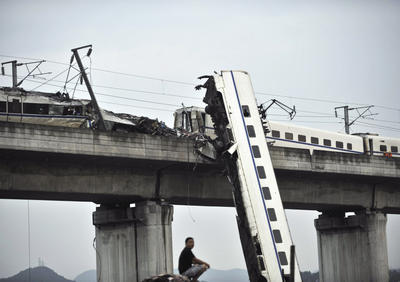corruption, faulty equipment and flawed procedures, all of which has have become evident in the past two years of construction and operation.
The massive HSR network initially grew together with the Chinese economy, becoming a symbol of Chinese ambition, technological prowess and innovation. The building frenzy peaked in June 2011, when the 1,318-kilometre Beijing–Shanghai high-speed line opened, reducing travel time between the country’s two economic powerhouses to less than five hours. A comparable train journey in the US with Amtrak would take at least 18 hours. Apart from high speeds, statistics show that new Chinese trains are now travelling much further: the average daily distance covered in 2006 was 671 kilometres and increased to 882 kilometres by 2010.
How did Chinese technological efficiency in HSR evolve so rapidly? During the planning phase, the bidding process for technical support was opened to foreign companies on the condition that they share technical knowledge with their Chinese partners. Kawasaki and Siemens accepted this condition, so the Chinese were able to blend the best parts of the Japanese Shinkansen and the German Intercity-Express in order to create their own advanced locomotives.
Statistics from China also show that the agricultural sector declined, while the service sector grew, meaning a higher need for rapid mobility developed. The network quickly proved successful, in line with this need for mobility with train speeds eventually peaking at 350km/h on the line between Shanghai and Nanjing. By contrast, during the 1990s Chinese diesel locomotives reached a maximum speed of 120km/h. The massive project was so impressive that Barack Obama referred favourably to it during his State of the Union address in January 2011.
In February 2011, five months before the Wenzhou crash, railways minister Liu Zhijun was dismissed from his post due to allegations of corruption. Liu, who was responsible for the rapid expansion of high-speed rail in China, was expelled from the Communist Party on 28 May 2012 on suspicion of fostering bribery and corruption throughout the Chinese rail system. Revelations of kickbacks and illegal contracts put a further dent in the prestigious HSR program, causing national embarrassment. But the worst was yet to come.
The triumphant feeling of those responsible for China’s high-speed rail development was shattered on 23 July 2011, when two high-speed trains collided on a viaduct in Zheijang Province, on the Ningbo–Taizhou–Wenzhou railway, killing 40 people and injuring 192. The collision was caused by a failure in the signalling system, which had been struck by lightning.
In the aftermath of the disaster, footage emerged of bulldozers burying several of the carriages, in what looked like a government cover-up of the disaster. This resulted in outrage from the Chinese public. The railways ministry quickly apologised, denying that there had been a cover-up. But by this point irreparable damage had been inflicted on the HSR project, which quickly became synonymous with distrust between the government and a furious population.
Changes were immediately implemented following the crash, with most train speeds reduced by 50km/h. Still, public confidence fell to an all-time low and resulted in a drop of around 30 million passengers in the months following the crash. In a bid to reassure the disgruntled public, a greater degree of transparency was imposed on the railway ministry by transferring jurisdiction over railway matters from the railway court system, to the civil courts.
By early 2012, the Chinese HSR system was beginning to struggle, with 70 per cent of projects delayed or suspended. The railways ministry is under a heavy cloud of debt and banks are reluctant to continue financing the expansion of HSR in China. The ministry has taken out loans of around US$37 billion and is failing to recoup money from passengers. The disastrous slowdown can be taken into context by the fact that nine new railway projects will be commissioned in 2012, down from seventy in 2011. While the glory days of HSR construction might have come to an end, the Chinese can still boast a hugely advanced network of high-speed trains. Rail travel in China is now much faster, smoother and more efficient than ever before, in what amounts to an infrastructure revolution that is still a long way away for Western Europe and the US.
Francis Broderick is a US journalist. He writes for Trenditionist.

